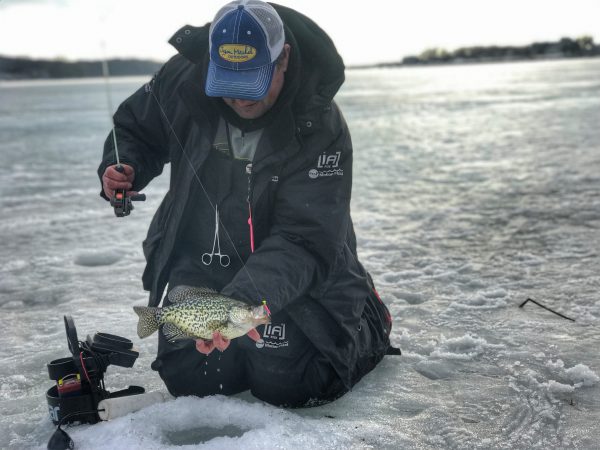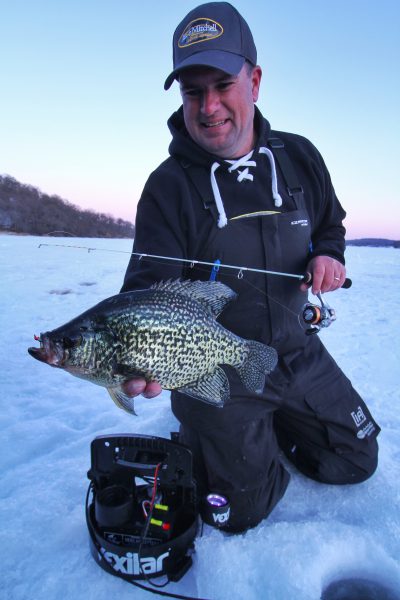Crappie on the Ceiling
Category: article
Nov 26th, 2019 by Keith Worrall
Modified Nov 26th, 2019 at 10:28 PM
Crappie on the Ceiling
By Jason Mitchell
Never say never and never say always with fishing but when it comes to catching big crappie throughthe ice, there are a few lessons that seem repeating. Doesn’t matter if you find crappie suspended over basins or classic wintering holes. Could be shallow weeds or pencil reeds. Maybe sharp breaking basin or channel edges. Perhaps you are fishing flooded brush piles, cribs or submerged timber. Wherever crappie swim, we often find a universal theme. In fact, this is the secret or trick if you will that separates that person who always seems to catch the biggest, baddest crappie. Doesn’t matter if I am in Michigan or Nebraska, if there is an angler who always seems to have a knack for sticking the biggest crappie, chances are that angler is fishing higher in the water column. Often right under the ice. There is a lesson to be learned here. If you are content to simply catch fish, fish the fish. Fish slightly above the fish you are marking with your electronics. If you want to try and catch the biggest crappie in the neighborhood, fish much higher above the fish. If you are fishing suspended fish that are fifteen feet down over twenty feet of water, fish five to ten feet below the ice. If you are fishing an eight-foot weed flat and most of the fish are running halfway down in the water column, go ahead and try fishing right below the ice. Get up above the fish. The reality is that you won’t catch as many fish but you will often catch the biggest fish.
The presentations can run the gamut but as a rule of thumb, this strategy doesn’t border on finesse. Soft plastic options like the Makki offer fish an easy to find profile or silhouette. Power fishing strategies with small spoons like the CPT Pinhead Minnow are also really gaining momentum in a lot of regions. Big crappie might have a mouth that is as big as a Styrofoam cup and crappie are indeed a predator. While there are times when fish can be difficult and require finesse, the reality is that crappie can often surprise us with their level of aggressiveness. For targeting the biggest crappie, don’t be afraid to fish high and don’t be afraid to go bold and big.

Big crappie are notorious for riding high in the water column. Aggressive presentations fished right below the ice often account for some of the nicest crappie we catch each winter.
Horizontal jigs paired with soft plastic profiles have been a big crappie staple the past decade. Many of the more popular plastics have been a larger minnow type profile. On horizontal jigs, you can get the jig to swim and kick forward by sliding a palomar knot back towards the hook. Sliding the knot back and letting the jig mover more horizontally does often seem to work well for catching these bigger fish. On occasions where crappie will rise high or show up high in the water column but won’t hit larger and more aggressive profiles, there are times when a more subtle vertical jig an be the ticket. Especially with unstable weather, heavy fishing pressure or just the classic midwinter doldrums when fishing seems to get tougher. We often use a similar minnow or Makki profile plastic but hook the plastic horizontal below a vertical jig. Vertical jigs just seem to move less water, have a more subtle footprint and a much smaller profile as fish look up at the jig. For simply covering water with an aggressive power fishing attitude, the spoon craze is a fun way to target aggressive fish. Many anglers are using spoons like the Pinhead Minnow without any bait or plastic. Too be fair, the Pinhead Minnow does have a small blade on the treble for an added bit of flash that seems to be a part of this lure’s allure. With the spoons, fish high and play keep away. Keep the spoon moving and make the fish chase the lure.
This high, big and bold routine probably catches the larger crappie in a school for a variety of reasons but I think there is a universal theme at play. The smaller crappie seem to like the security of the pack. Small fish don’t like to be exposed above the rest of the school. Small fish don’t seem to like to be alone. Small fish know they are a meal. Big fish have a different swagger. Big fish beat the small fish to a meal and don’t worry about exposing themselves above the pack. By fishing as high as possible in the water column, often pushing the limit to the bottom of the ice… you offer a presentation that the big fish will find and eat. You are also outside the limit and comfort as to what small fish are willing to risk for a meal. This ceiling or elevation game is perhaps the easiest way to sort out the top end fish. By pushing how far fish will rise to hit the lure, remember as well that a fourteen-inch crappie usually beats a ten-inch crappie in a race. What we have also found is that so often, the bigger fish are often lone wolfs.
If your goal is simply to catch the biggest crappie you can this winter, cheat higher in the water column. Fish so high in the water column that you start to catch notably less fish. What you will often find is that you will start to catch some of your very biggest fish.
